Evaluating the Worth of Burj Khalifa: An In-Depth Study
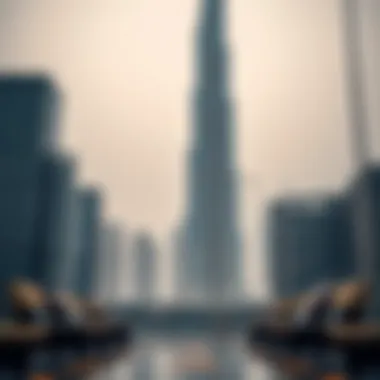
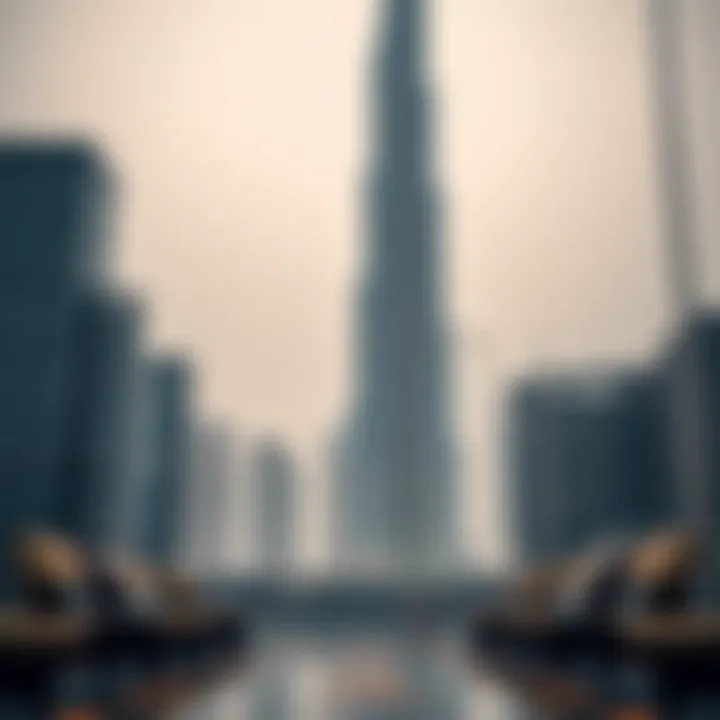
Intro
Burj Khalifa, a towering marvel rising to 828 meters, is not just a display of architectural brilliance; it serves as a crystallized symbol of Dubai's ambition and growth. In today's fast-paced economy, understanding the worth of such an iconic structure is essential for various stakeholders, ranging from investors to market analysts. This exclusive exploration examines multiple layers of valuation that go beyond mere construction costs.
As we dissect this skyscraper's financial standing, the narrative will touch on its incredible construction journey, how it has shaped tourism in the region, and its broader influence on Dubai's dynamic economy. Each element contributes to a rich tapestry that tells not just how much the Burj Khalifa is worth but why it holds significant value in the grand scheme of things.
The burgeoning tourism industry, driven in large part by Burj Khalifa, adds another dimension to its worth. How does this influence market trends? Can the yield from tourism give us clues about potential investment opportunities? These are some of the critical questions we’ll cover.
Through this journey, we aim to give a well-rounded perspective that empowers home buyers, real estate agents, developers, and investors alike. Given that you're here to uncover the true essence of Burj Khalifa's valuation, let’s not beat around the bush any longer. \n
Market Insights
Current Market Trends
The real estate market in Dubai exhibits unique characteristics. With the rise of global interest, particularly in luxurious properties, the Burj Khalifa stands out. Recent trends indicate a steady uptick in prime developments, fueled by strong tourism and a growing expatriate population looking to settle in the UAE.
Investment stakeholders are keenly observing the sector for signs of growth. One way Burj Khalifa influences market movements is through comparative value. Properties in proximity to famous landmarks, like the Burj Khalifa, often see enhanced appreciation rates, a phenomenon that has been evident in various segments of the Dubai market.
Price Analysis and Forecasts
Historically, the price valuation of properties surrounding Burj Khalifa has soared. Recent reports suggest that high-end properties have appreciated by about 5-7% year-on-year, capturing the attention of international investors. As reports circulate about the future recovery of the global economy post-pandemic, Dubai is likely to remain on many investors' radars.
Factors Impacting Prices
- Tourism growth: As visitor numbers increase, so does the demand for property.
- Cultural significance: The Burj Khalifa remains a cultural hub, driving up nearby property values.
- Economic stability: With steady economic policies, Dubai is increasingly seen as a safe haven for investments.
"Investing in landmark properties such as Burj Khalifa can provide returns much higher than average due to their unique position in the market." – Local real estate analyst
In wrapping up this section, it’s important to recognize that Burj Khalifa’s worth is not just a numerical figure. It represents a myriad of financial and cultural narratives that enhance its position in both local and global markets.
Investment Opportunities
Top Areas for Real Estate Investment
The vicinity of Burj Khalifa is ripe for real estate investments. Properties ranging from luxury apartments to star-rated hotels are gaining traction. Areas to consider include Downtown Dubai and Dubai Marina.
- Downtown Dubai: Home to the Burj, this area sees consistent demand due to its location.
- Dubai Marina: Offers a modern lifestyle and is popular among high-net-worth individuals.
ROI and Yield Calculations
When analyzing investment opportunities, calculating return on investment (ROI) is imperative. Properties near Burj Khalifa have shown high ROI potential due to their luxurious nature and tourist draw.
In general, numerous investors find that units in high-rise buildings can yield anywhere from 7% to 9% annually; however, premium locations like those surrounding Burj Khalifa may fetch even more.
Foreword to Burj Khalifa's Valuation
When it comes to understanding the Burj Khalifa, one might first think about its staggering height and architectural brilliance, but the essence of this analysis dives deeper into its valuation. Evaluating the worth of the Burj Khalifa encompasses not just the sheer numbers behind its construction but also the multi-faceted implications it has on Dubai's economy and beyond.
In this section, we will explore why a thorough valuation is crucial. First off, investors and developers need clarity on potential returns. The Burj Khalifa, being tied to high-profile tourism, commercial activities, and luxury residential options, serves as a key case study in real estate investment. Knowing its valuation helps in making educated choices about property investments in the vicinity and similar high-value projects.
Additionally, understanding the financial aspects gives insight into the building's impact on the local and national economy. It provides a window into how monumental structures can potentially elevate local markets. Moreover, for homebuyers, gauging the worth of such iconic landmarks can shape their decision-making process. They want assurance that they’re investing wisely in a property that is not just a roof over their heads, but a piece of a celebrated skyline.
Behind the numbers, the valuation also considers the cultural significance of the Burj Khalifa. This building has become a symbol of modern progress and innovation. Assessing its worth isn’t solely a monetary evaluation; it reflects its status in global culture and iconic architecture.
Thus, we see that the valuation of the Burj Khalifa spans a wide spectrum. It’s about understanding past investments, current market dynamics, and future potential. Investors, developers, and real estate agents alike stand to benefit from a nuanced grasp of these elements as the narrative of Burj Khalifa unfolds in the following sections.
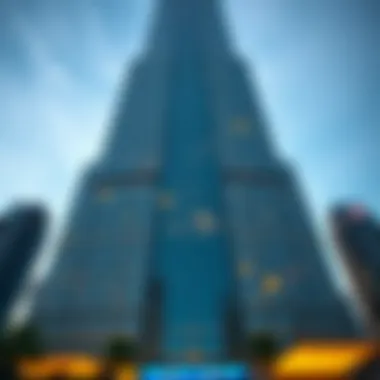
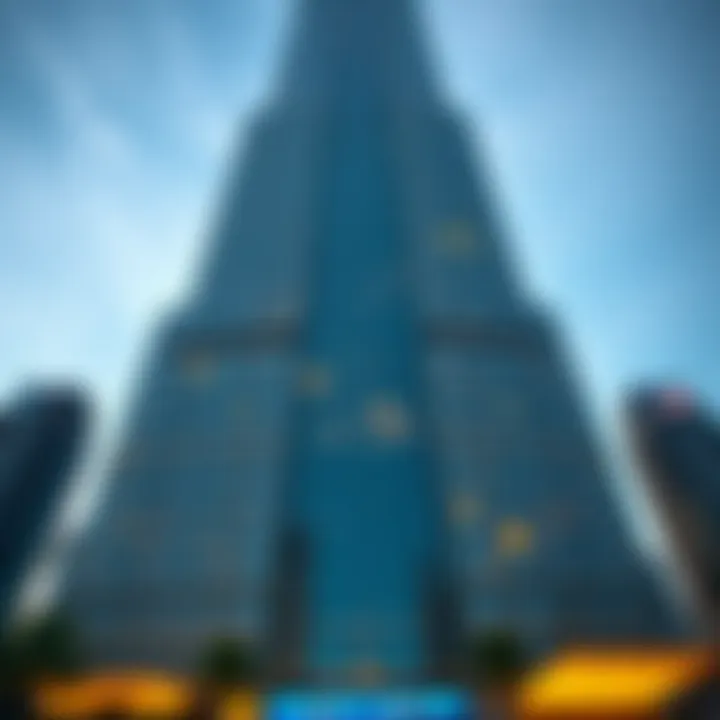
Construction Costs of Burj Khalifa
When looking at the valuation of Burj Khalifa, the construction costs stand out not just as a figure but as a component reflecting its grandeur and ambition. These costs help frame its value not only in financial terms but also in the rich narrative that surrounds its inception and construction. An understanding of these figures gives investors and analysts context surrounding the financial commitments necessary to create an architectural wonder.
Burj Khalifa symbolizes more than just height; it epitomizes the merging of innovative engineering with aesthetic beauty, and the costs incurred during construction reveal the intricate processes behind this iconic structure. These figures are significant not only for market analysts but for home buyers and real estate agents who assess the ripple effects on surrounding property values and potential returns on investment.
Breakdown of Initial Investments
Investigating the breakdown of initial investments reveals how the hefty price tag came to be. The initial investments for Burj Khalifa totalled approximately 1.5 billion USD, a staggering amount that underscores the complexity of its construction. The costs can be categorized into several key segments:
- Land Acquisition: Before a single brick was laid, securing the land was paramount. The site’s prime location added significant value right from the get-go.
- Materials and Design: From the high-strength concrete used in its structure to the delicate glass for its exterior, material costs formed a substantial part of the overall investment.
- Labor Costs: The unique design necessitated a skilled labor force, often sourced from different corners of the globe, incurring costs that reflect both wages and logistical challenges.
- Safety and Compliance: Ensuring that the building met safety standards during its construction involved further investments. Safety measures were not just an afterthought, rather integral to the building's ultimate design ethos.
This comprehensive breakdown reveals that every dollar spent was meticulously planned to ensure the highest quality and durability possible, allowing it to stand as a beacon of engineering prowess.
Financing Mechanisms Employed
Understanding the financing mechanisms behind Burj Khalifa is essential for grasping its financial framework. The construction was funded through a mix of sources which includes:
- Government Funding: A significant portion of finances came from the Dubai government, emphasizing its importance to national pride and image as a global city. The government’s backing acted as a safety net.
- Private Investment: Partners like Emaar Properties played a critical role in gathering private investments. Investors often see landmark projects as a means to boost brand value and business opportunities.
- Loans and Bonds: Financial institutions also contributed through loans, backed by expected revenue from tourism and real estate sales, highlighting the confidence placed in Burj Khalifa's ROI potential.
"Burj Khalifa represents not only a financial investment but a vision of what Dubai could achieve in terms of fame, tourism, and architectural marvels.”
Overall, the intricate web of financing mechanisms illustrates the complexity and foresight required to bring Burj Khalifa from conceptualization to reality. This blend of investment strategies not only helped lift this extraordinary project from blueprints to skyscraper but also established a precedent for future developments in the region.
Successful construction, therefore, was not just a matter of money; it was a fusion of budgeting acumen, clever financing, and a shared vision of exceeding expectations.
For additional insights on Burj Khalifa's construction aspects, you can visit Britannica or the comprehensive overview on Wikipedia.
These details lay the groundwork for understanding how Burj Khalifa came to be, but they also shine a light on the broader economic and architectural implications of such an endeavor.
Current Market Value Estimations
Understanding the current market value of Burj Khalifa is pivotal for several reasons. First and foremost, it serves as an indicator of the overall economic vitality in Dubai and reflects the demand for high-end properties. As the tallest building in the world, Burj Khalifa isn’t just a physical structure; it's a benchmark against which other iconic properties are measured. Investors, home buyers, real estate agents, developers, and market analysts all track this valuation closely, as it influences investment decisions in both local and global contexts.
An accurate assessment of the market value incorporates various elements, some of which are unique to high-value properties like Burj Khalifa. Not only does it involve analyzing the financial investment put into the property, but also factors in its operational revenues, potential for tourism, and overall stature within the architectural landscape. Like a finely tuned instrument, the evaluation requires an understanding of both quantitative and qualitative aspects, ensuring that all angles are given due attention.
Assessment Methods for High-Value Properties
In gauging the market value of a prestigious asset like Burj Khalifa, experts use several assessment methods. Typically, these can include:
- Income Approach: This involves calculating the potential income generated from the building, looking at factors such as rental yields and visitor spending. The Burj Khalifa, with its observation decks and upscale hospitality offerings, stands to generate substantial revenue, making this method particularly relevant.
- Cost Approach: This method examines the cost to replace the building, accounting for depreciation. While Burj Khalifa carries a hefty original construction price tag, assessing the replacement costs can give insights into its ongoing market value.
- Comparative Market Analysis (CMA): This method analyzes similar properties in Dubai and beyond, offering a benchmark against which Burj Khalifa’s value is measured. Looking at other iconic structures provides context to its worth, especially as new developments arise in the competitive skyline of Dubai.
Although these are merely a few methodologies, they intertwine to give a fuller picture of what Burj Khalifa is worth today.
Comparative Analysis with Other Iconic Structures
A comparative analysis can yield enlightening insights into the valuation of Burj Khalifa. By examining properties such as the Shanghai Tower, One World Trade Center, and the Abraj Al Bait Towers in Mecca, we can glean how similar structures stack up in terms of market value and desirability.
- Shanghai Tower: While it stands as the second tallest building globally, it attracts a different demographic and offers distinct features. Its valuation might be different based on factors like location and amenities.
- One World Trade Center: This building carries significant historical weight, which can inflate its market value. Understanding how emotional and cultural resonance impacts valuation helps sharpen the focus on Burj Khalifa's place in the market.
- Abraj Al Bait Towers: With its prime location and unique design, comparing these features with the Burj Khalifa can elucidate different valuation determinants that might not be immediately apparent.
Ultimately, through such comparisons, investors and stakeholders can ascertain whether Burj Khalifa is keeping pace with, outperforming, or lagging behind other landmarks.
Insight: The evaluations are a mix of art and science; they require not just numerical analyses but an understanding of the market and cultural significance that shapes high-value properties like Burj Khalifa.
Access additional insights on real estate valuation from sources like BBC or Investopedia. For a deeper look into architectural marvels, consider exploring Britannica or Wikipedia for histories and statistics on each featured structure.
Economic Contributions of Burj Khalifa
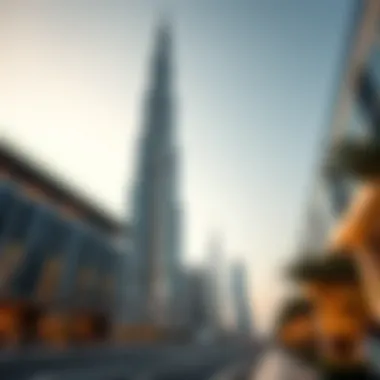
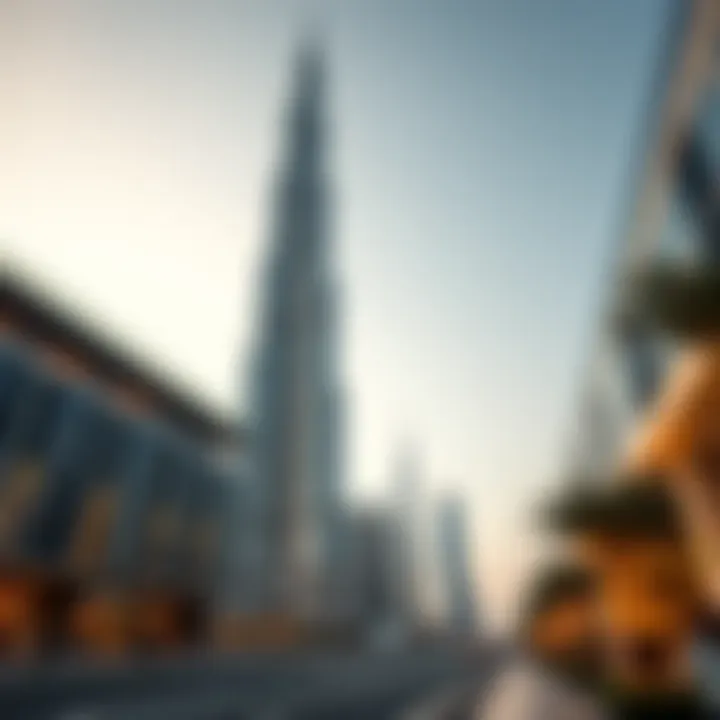
Burj Khalifa, more than just a towering monolith in Dubai’s skyline, stands as a testament to economic ingenuity and opportunity. Understanding its monetary impact is crucial for investors, real estate agents, developers, and market analysts alike. The building has become a linchpin of economic activity, creating avenues for revenue generation and influencing the overall prosperity of Dubai. Two primary components capture this economic influence: tourism and real estate.
Tourism Revenue Generation
The Burj Khalifa's towering presence undoubtedly attracts tourists from every corner of the globe. Just standing at the base of this magnificent structure invokes a sense of awe that compels many to whip out their cameras. According to the latest statistics, millions visit the Burj every year, contributing significantly to Dubai’s tourism revenue. People crave experiences, and the Burj Khalifa offers an extraordinary one—its observation deck boasts stunning panoramic views of the sprawling city and ocean beyond.
The attraction also hosts a variety of events, further enticing visitors. Special occasions like New Year’s Eve fireworks display, which is among the best globally, increases foot traffic. This event alone ropes in thousands, amplifying local business activities. It’s not just the view that draws the crowd; it’s the whole experience wrapped in luxury dining, shopping at the adjacent Dubai Mall, and leisure activities around the area.
Investing in tourism infrastructure around the Burj Khalifa has also paid off. Restaurants and retailers have sprung up, each benefiting from the visitor surge. This ripple effect extends into the local economy, creating jobs and supporting small businesses, thus showcasing how one iconic structure can act as a magnet for financial gain.
Impact on Local Real Estate Market
The ripple effect can also be observed in the local real estate market. The area surrounding Burj Khalifa has transformed into one of the most sought-after locations for both residential and commercial properties. Property values district skyrocketed due to the coveted address. Living near the Burj Khalifa isn’t just about aesthetic appeal but also about status. Investors are keenly aware that properties here often yield higher returns.
This upsurge has caused a significant influx of developments, with many new luxury residences and corporate headquarters in the proximity. The demand for real estate in Downtown Dubai shows no signs of slowing down. As property prices rise, so too does the need for diverse types of housing to accommodate the workforce supporting the burgeoning commercial activities.
"The Burj Khalifa has not only redefined the skyline but has also reshaped the economic landscape of Dubai, generating opportunities that ripple through various sectors."
In summary, the economic contributions of Burj Khalifa extend beyond its immediate financial gains. This architectural wonder affects tourism revenue and influences the real estate market in profound ways. It acts as a cornerstone in Dubai’s economic framework, illustrating how ambitious projects can elevate a city's global standing while providing tangible benefits to the local economy. Investors and analysts must consider these elements to appreciate the full scope of Burj Khalifa’s worth.
Architectural Significance of Burj Khalifa
The Burj Khalifa stands tall, not just in height but in its architectural and engineering significance as well. This structure is more than a mere skyscraper; it embodies an amalgamation of innovation, culture, and ambition. As we delve into its architectural aspects, it is vital to understand how these elements contribute to its value both symbolically and economically.
Innovative Engineering Solutions
The engineering of Burj Khalifa is nothing short of revolutionary. It has pushed the boundaries of what contemporary architecture can achieve. Several innovative solutions were employed during its construction, many of which address common challenges faced in high-rise buildings.
- Vertical Transportation: One of the groundbreaking achievements is its elevator technology. The Burj Khalifa boasts the world’s fastest elevator, capable of traveling at six meters per second. This innovation significantly improves the efficiency of moving thousands of daily visitors and residents.
- Super-Strong Materials: The use of a high-performance concrete mix that could withstand the extreme pressure at its towering heights was critical. Additionally, a special kind of cladding reduces heat gain while withstanding sandstorms typical of the Dubai climate.
- Wind Engineering: The design of Burj Khalifa took into account wind dynamics. Its shape minimizes the oscillations caused by wind, ensuring stability and comfort for occupants. This advanced grasp of aerodynamics is crucial for the safety of occupants and operations.
These innovations position Burj Khalifa not only as an architectural wonder but also as an inspirational blueprint for future high-rise constructions.
Contributions to Modern Skyscraper Design
Burj Khalifa has set a benchmark in skyscraper design, influencing numerous projects around the world. Its architectural elements serve as a guide for other structures seeking to combine aesthetic beauty with functional efficiency. Key points of its contributions include:
- Aesthetic Design: The triple-lobed footprint of the building resembles a desert flower, providing not only visual appeal but also increased facade area, allowing for numerous windows and better views.
- Sustainability Features: The design incorporates various sustainable elements, such as a condensate recovery system that recycles water and uses less energy compared to similar buildings.
- Cultural Embodiment: Burj Khalifa doesn’t only represent engineering feats; it integrates local culture by incorporating Islamic architectural motifs, ensuring it resonates deeply with its surroundings.
Indeed, Burj Khalifa serves as both an emblem of advancement and a source of pride for Dubai. Its influence extends beyond regional borders, offering a comprehensive model for modern skyscraper design in urban settings around the globe.
"A landmark not only of engineering but also of the human spirit to create and innovate, Burj Khalifa stands as a symbol of what is possible."
In essence, the Burj Khalifa encapsulates the essence of architectural progress. It’s a landmark of innovation, engineering prowess, and cultural significance that continues to make waves in the real estate and architectural fraternity. As it inspires and guides, its impact on future constructions will undoubtedly leave indelible marks on skylines everywhere.
Cultural Impact on Dubai and Beyond
The Burj Khalifa stands not just as an architectural marvel but also as a cultural touchstone for Dubai and the wider world. Its presence has done more than just redefine the city's skyline; it has likewise transformed its identity, asserting Dubai's place on the global map.
Symbolism of Burj Khalifa
Nestled in the heart of Dubai, the Burj Khalifa exemplifies ambition and innovation. The building serves as a beacon of modernity, representing the aspirations of a rapidly developing nation. Its design resembles a stalagmite, reaching for the sky and suggesting that even in the desert, one can grow and thrive. This symbolism resonates emotionally with both locals and visitors alike, encapsulating the spirit of resilience and progress.
Moreover, the tower has become an emblem of luxury. High-end restaurants, upscale hotels, and exclusive lounges within the Burj cater to an affluent clientele. The tower's observation decks attract millions yearly, serving as a platform for Dubai’s hospitality industry and enhancing the city’s status as a premier tourist destination. The Burj Khalifa is, therefore, not merely a building; it’s an icon that exemplifies the opulence and ambition inherent in Dubai’s cultural identity.
Once seen as something only a few could dream of, the Burj Khalifa makes what many thought impossible a tangible reality, offering surrounding communities additional reason to take pride in their city. It represents a delightful convergence of various themes: creativity, culture, and community spirit.
Burj Khalifa in Media and Art
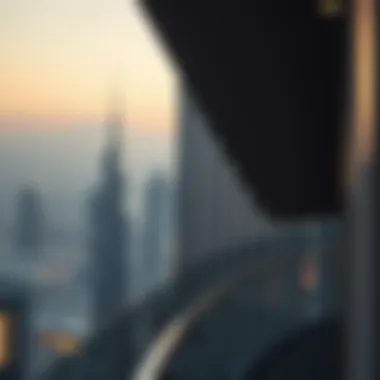
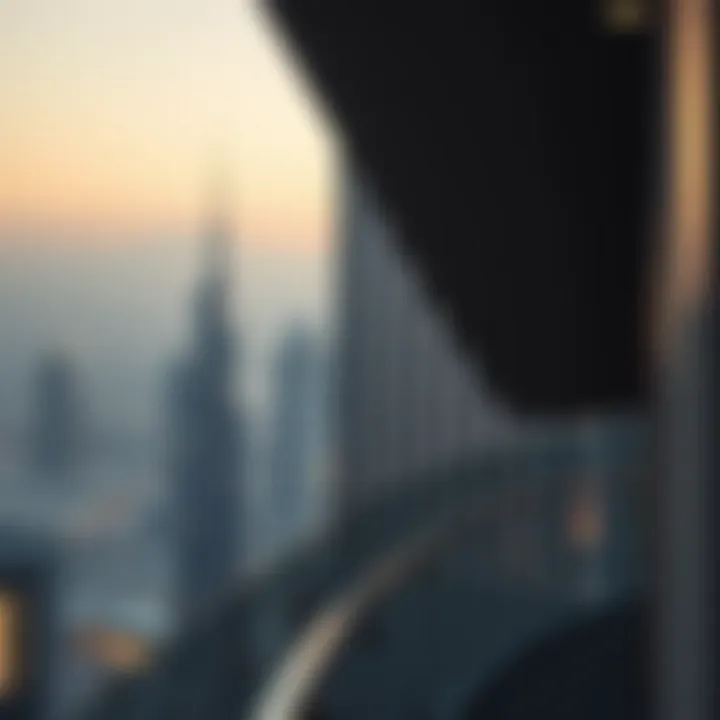
The influence of the Burj Khalifa transcends its physical presence. It has been prominently featured in various forms of media, from films to literature, and has inspired countless artists around the globe. The tower's stunning silhouette often adorns movie backdrops, embedding it in popular culture. For instance, who can forget the breathtaking scenes in movies like "Mission: Impossible – Ghost Protocol" where Tom Cruise made a daring climb on the building's exterior? This cinematic appearance not only amplified the building's visibility but also cements its place in the collective consciousness of cinema fans.
In literature, the Burj Khalifa serves as a metaphor for transformation and dynamism. Authors have used the tower as a symbol in various narratives that pertain to ambition, the contrast between old and new Dubai, and the aspirations of migrant workers. Additionally, its lighting displays and fireworks on New Year's Eve have garnered global attention, turning it into a focal point of celebrations and reinforcing its cultural significance.
Local artists and photographers often draw inspiration from the Burj Khalifa, reflecting its grandeur in their works. The tower has become a muse for many, something that drives the creative spirit of the region. Furthermore, art exhibitions held in and around the Burj provide platforms for both established and emerging artists to showcase their work, promoting cultural exchanges that resonate beyond Dubai.
Challenges Affecting Value
Burj Khalifa stands not just as an emblem of architectural brilliance, but also as a complex player in the economic theatre of Dubai. Evaluating the worth of this skyscraper involves grappling with various challenges that can substantially sway its valuation. These challenges are not only relevant for investors or potential buyers but also for stakeholders like real estate agents and market analysts who require an in-depth understanding of the dynamics involved. Awareness of these challenges can provide insights into the future financial health of Burj Khalifa, making this section indispensable.
Economic Fluctuations
Fluctuations in the global and local economy have a profound impact on the real estate market, and the Burj Khalifa is no exception. When the economy breathes easy, investments tend to soar. Conversely, when it takes a tumble, even iconic structures can find themselves in a tight spot. Consider how the 2008 global financial crisis shook confidence in luxury developments worldwide, affecting property valuations across the board. The Burj Khalifa, being a key asset, is intertwined with these economic waves.
For instance, during economic downturns, consumer discretionary spending shrinks. This can affect tourism and, in turn, the income generated from Burj Khalifa’s attractions, such as the observation deck and fine dining. In tougher times, potential buyers and investors may shy away, fearing negative returns on their investments. It’s crucial to monitor economic indicators like GDP growth rate, unemployment rate, and tourism statistics when assessing the Burj Khalifa's financial prospects.
Competitive Developments in Dubai
The skyline of Dubai is ever-evolving, and new developments continuously challenge Burj Khalifa's supremacy. Recent trends show an upsurge in the construction of mega-projects, which can dilute the uniqueness that makes Burj Khalifa so special. A good example is the Jeddah Tower in Saudi Arabia, which aims to surpass the height of the Burj Khalifa once completed. This kind of competition serves as a double-edged sword.
On one hand, it keeps the spotlight on skyscrapers as cultural and economic icons. On the other hand, as new structures emerge, the market may see a shift in stature associated with towering edifices. If investors view Burj Khalifa as becoming 'just another building', its valuation could suffer. To maintain its prestigious status, ongoing renovations and upgrades are paramount. This ensures that Burj Khalifa remains relevant in the age of architectural wonders that are constantly vying for attention and investment.
In the ever-fluctuating real estate landscape, being attuned to such challenges helps stakeholders strategize more effectively, ensuring that Burj Khalifa continues to shine as a beacon in Dubai's ever-expanding horizon.
The value of Burj Khalifa is as much about its past achievements as it is about navigating future challenges.
Future Prospects for Burj Khalifa’s Valuation
When exploring the layered complexities of Burj Khalifa's valuation, looking into its future prospects is essential. This segment is not simply a prediction of numbers; it encompasses the socio-economic landscape, the opulence of the real estate market in Dubai, and potential enhancements that can augment its worth. Investors, property seekers, and market analysts must recognize that understanding these future trajectories can guide strategic decision-making in a rapidly evolving environment.
Expected Trends in Dubai Real Estate
In recent years, the landscape of Dubai's real estate market has morphed considerably. This shift can be attributed to a myriad of factors, including growing expatriate populations, economic diversification efforts by the government, and the ongoing development of infrastructural projects. Here are some notable trends:
- Resilient Demand for Luxury Properties: With numerous multinational companies setting up base in Dubai, there's an uptick in demand for high-end residential units. This trend supports a sustained interest in properties like Burj Khalifa, which is not just a building but a lifestyle statement.
- Affordable Housing Development: While luxury remains in high demand, the government’s initiatives to introduce affordable housing options can create a balanced real estate environment. A mixture of value propositions can attract more residents and visitors, indirectly boosting Burj Khalifa’s relevance as a rental or investment choice.
- Green Building Initiatives: The global emphasis on sustainability has trickled down into Dubai's real estate planning. Future developments are likely to include advancements in energy efficiency and sustainable designs, which could offer a competitive edge to landmark buildings like Burj Khalifa.
- Technological Integration: Smart homes and tech-driven developments are finding their place in Dubai’s real estate sector. Upgrading Burj Khalifa with state-of-the-art technologies could ensure it remains a pivotal component of the city’s skyline well into the future.
Potential Renovations and Upgrades
As the adage goes, "you can’t teach an old dog new tricks," but some tricks are worth perfecting. Burj Khalifa, while cutting-edge when it celebrated its launch, could benefit from modern upgrades. Think of potential renovations as a method to future-proof its status:
- Smart Building Technologies: Implementing advanced building management systems can optimize energy use and enhance the comfort of inhabitants and visitors. Innovations like integrated sensors for heating, ventilation, and air conditioning could be essential upgrades.
- Aesthetic Enhancements: Periodic renovations to the façade and interior spaces can keep the building visually appealing. Whether through art installations or modern lobby designs, aesthetics contribute significantly to property perception.
- Event Spaces Expansion: Adding versatile event venues or recreational areas can attract more visitors and business bookings. Following the current trend of experiential offerings, upgrading spaces for larger events like concerts, exhibitions, or exclusive dinners could increase foot traffic.
- Sustainability Features: The introduction of green roofs, rainwater harvesting systems, or solar panels can not only lower operational costs but also enhance Burj Khalifa's brand image as a leader in sustainable architecture.
In summary, the future value of Burj Khalifa hinges strongly on the adaptability of its design and the overall market trends that surround it. With the right foresight and strategic enhancements, this architectural marvel can continue to awe and inspire for many years to come.
"Investing in the future requires a deep understanding of evolving landscapes; Burj Khalifa stands at the crossroads of tradition and innovation."
A comprehensive understanding of these trends and renovations will not only inform potential investors but also help local businesses leverage the increasing footfall generated by Burj Khalifa.
End: Understanding the Value of Burj Khalifa
The Burj Khalifa stands as a beacon of ambition and achievement, symbolizing the evolution of modern architecture and engineering. In encapsulating its worth, we embark on an exploration of numerous layers: from its astronomical construction costs to its significant impact on the local economy.
Understanding the valuation of such an iconic structure involves not merely numbers but also qualitative assessments. The Burj Khalifa has transcended its physical presence to become an emblematic figure, showcasing Dubai’s aspirations on the world stage. However, its worth does not only lie in its architectural splendor but also in its ability to stimulate various sectors, such as tourism, hospitality, and commerce.
"The Burj Khalifa isn’t just the tallest building, it’s a defining asset that shapes the economic landscape of Dubai."
To synthesize the insights presented:
- Financial Significance: The staggering construction costs and recurring operational expenses play a crucial role. Investors and real estate analysts must keep these elements in focus while appraising potential ventures surrounding such landmark structures.
- Cultural Reflection: The Burj Khalifa has been featured in numerous films, advertisements, and art, establishing a cultural narrative that enhances its public perception. Thus, its value integrates cultural relevancy and popularity, enhancing investment appeal.
- Market Dynamics: Evaluating the Burj Khalifa also entails consideration of economic fluctuations and competition within the real estate market. As new developments emerge in Dubai's skyline, it’s vital to assess their impact on the Burj's standing in the market.
- Future Prospects: The potential for renovations or upgrades, alongside expected trends in Dubai’s real estate sector, shapes the narrative of the Burj Khalifa’s valuation trajectory. It positions the building not merely as a static entity but as a dynamic component of the local economy.
In essence, grasping the worth of the Burj Khalifa allows stakeholders—whether investors, home buyers, or market analysts—to navigate its complexities with nuanced understanding. This iconic skyscraper is more than a structure; it is an investment with historical significance, continuing to mold its surroundings as Dubai forges ahead. For more on its architectural significance, visit Britannica.
Moreover, insightful resources for market trends can be found on forums such as Reddit or economic analyses through governmental sites like UAE Government. Keeping abreast of these perspectives ensures one captures the full essence of what makes the Burj Khalifa an integral part of Dubai's narrative.











